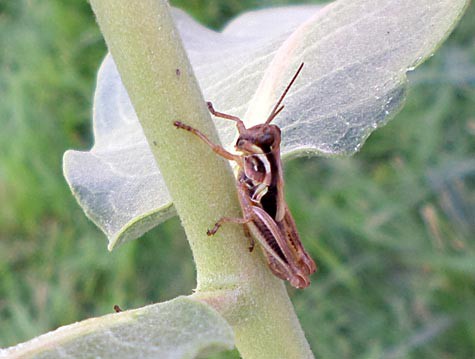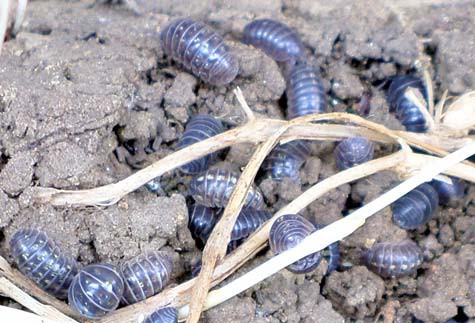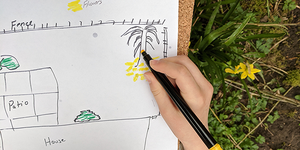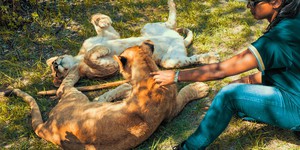Summary

Introduction
Have you ever wondered how many different types of animals live around your home, like in your backyard or a local park? Animals come in all shapes and sizes, each a small part of the amazing diversity of life. These differences can help people use systems to classify animals into different groups. One way people classify animals is by their phylum. Do you know which phylum you belong to? In this science activity, you will investigate the diversity (or biodiversity) of the animal life around your home and try to figure out which phylum most of the animals belong to.Materials
- Sheet of paper
- Pencil or pen
- Optional: Digital camera to take pictures
- Optional: Magnifying glass
- An observation location, such as a backyard, park, community garden, open field, lake, stream, etc. It should be a place you like to explore and where you think you might find a diversity of organisms.
 Image Credit: Teisha Rowland, Science Buddies / Science Buddies
Image Credit: Teisha Rowland, Science Buddies / Science Buddies
Instructions
- At a good time you picked to do your investigation, bring your sheet of paper and pen or pencil (and digital camera and magnifying glass, if desired) to the observation location you decided on.
- Pick a small part of the location to investigate first. For example, it could be a pile of dead leaves, some shady rocks, a patch of lawn, old logs, dry weeds, a tree, etc. (These are all different "microhabitats.")
- Carefully look for animals in that microhabitat. You may want to turn over rocks or logs to look for animals. On your sheet of paper, write down what type of animals you see. (For example, maybe you see a bird, earwigs, or spiders.) Do not worry if you cannot identify something right away — you can write down a description, make a drawing, or take a picture, and try to identify it later.What animals do you see? What kind of microhabitat are they living in? (Is it dry, damp, has plants, rocks, etc.?)
 Image Credit: Teisha Rowland, Science Buddies / Science Buddies
Image Credit: Teisha Rowland, Science Buddies / Science Buddies
- Move on to another microhabitat and similarly investigate it. What animals do you see in this area? Do any of the animals look like different species of types you saw already? What is the microhabitat like, and how is it similar or different from the previous one?
- Try to explore at least five different microhabitats at the observation location, if possible.Do some animals seem to prefer certain types of microhabitats (such as damp ones or dry ones) more than other animals?
- Once you are done investigating the observation location, try to categorize the animals you found by their phylum. Depending on where your observation site is, the phyla you are most likely to encounter are chordata, arthropoda, mollusca, and annelida. Chordates include all vertebrates (like us, dogs, cats, frogs, fish, cows, birds, etc.), while arthropods include insects, centipedes, millipedes, shrimp, pill bugs, etc., mollusks include snails and slugs, and annelids include earthworms.Which phylum did you find the most animals (i.e., greatest number of different species) for? Which phylum was the most difficult to find? Were there some phylum that you could not find at all? How diverse do you think animals are in your region? Did you consistently find certain animals in a specific type of microhabitat?
What Happened?
The types of animals you saw depends on where your observation location is, but for most backyards, parks, gardens, fields, etc., the phylum that most of the different animals belong to is arthropoda. Some of the most common arthropods you would see in North America include various flies, beetles (including ladybugs), spiders, roly polies, grasshoppers, centipedes, millipedes, earwigs, ants, butterflies, wasps, crickets, and many others. You may also have seen mollusks, such as snails and slugs (which belong to the mollusca phylum), as well as earthworms (if you dug around in soil — these belong to the annelida phylum). If you counted yourself in your survey, then you also saw at least one member of the phylum chordata! Other common chordates you may have seen include squirrels and birds.Digging Deeper
From the largest elephant to the tiniest water flea, all animals have unique characteristics. Based on their shared characteristics, animals are put into categories called "phyla." (A phyla is specifically a taxonomic ranking.) There are perhaps as many as 35 different phyla, but most phyla are very uncommon. Scientists recognize eight major phyla to describe most common animals: porifera, cnidaria, platyhelminthes, annelida, mollusca, arthropoda, echinodermata, and chordata.
Depending on where you live, the phyla you encounter most frequently may be chordata, arthropoda, mollusca, and annelida. Chordata is the most well-known group, even though it is quite small, because it includes all of the vertebrates. It is the phylum we belong to, along with most of our pets (dogs, cats, rabbits, rats, fish, frogs, salamanders), farm animals (cows, pigs, lamb, chickens), and zoo animals (zebra, lion, tiger, panda, giraffe, polar bear, etc.). Arthropods are invertebrates and include insects (like beetles, butterflies, flies, bees, wasps, grasshoppers, and ants), centipedes, millipedes, spiders, shrimp, crayfish, pill bugs, and many others. Mollusca includes snails, slugs, bivalves (e.g., clams and oysters), squid, and octopus. Annelids are segmented worms and include earthworms (which are used for compost and gardening) and aquatic worms.
Ask an Expert
For Further Exploration
- In this activity you investigated a single observation location, but you could try surveying two or more locations and compare them. How do your local parks compare to each other? If you live near the coast, how does a shoreline compare to a park? How do the species compositions change? Tip: If you investigate a marine location, you will want to do some background research on other common phyla that might live there.
- Make a species map to figure out how different animals are distributed in your observation location. To do this, first make a map of your observation location, marking locations of structures such as your house, a patio, shed, trees, etc., and make several copies of the map. Then repeat this activity but this time investigate the entire location and use a different copy of the map for each different type of organism you find, coloring in the map where you find that type of organism. What types of areas do certain species seem to prefer? Which areas have the most different kinds of species, and which have the fewest?
- Your wildlife observations can be helpful for several different citizen science projects. For example, you could use your investigations to contribute to Invasive Species Mapping Made Easy!, the Lost Ladybug Project, School of Ants, Bee Hunt!, Project Squirrel, Project FeederWatch, or Wildlife Sightings. What invasive organisms are in your area? What are your local populations of ladybugs, ants, bees, squirrels, birds, and other wildlife animals like?
Related Resources
Project Ideas
Links
- Blog Post: Biodiversity at Halloween: A Spider Variety Show
- Blog Post: Desks Piled High, and Lizards for Lunch
- Blog Post: Creative Summer Science: A Science Collection











